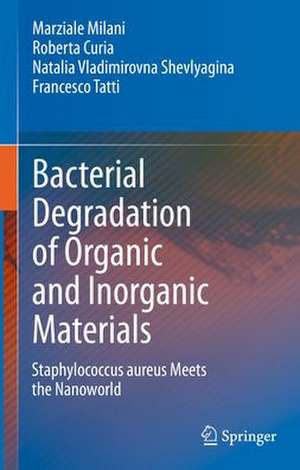Bacterial Degradation of Organic and Inorganic Materials: Staphylococcus aureus Meets the Nanoworld
Autor Marziale Milani, Roberta Curia, Natalia Vladimirovna Shevlyagina, Francesco Tattien Limba Engleză Hardback – 23 mai 2023
This interdisciplinary work deals with the bacterial degradation of organic and inorganic materials such as prosthetic devices and the consequent production of non-engineered nanoparticles (NPs). Focus is put on the interaction of these, often toxic, NPs with the environment, the microorganisms and the host human body.
Electron Microscopy is the method of choice to investigate bacterial colonization and degradation of plastic polymers. Hence one section of the book is fully dedicated to the most recent and interesting microscopy technologies in microbiology and soft matters.
The final chapter of the book on the complex and multivariate relationships between a microscopist and electron microscopy images is dedicated to Lyubov Vasilievna Didenko (1958 – 2015), a passionate researcher who contributed substantially to the field of Electron Microscopy research and its applications in studying bacterial-polymer interactions.
The book addresses researchers and advanced students working in general and clinical microbiology, nanobiology, materials sciences and image analysis fields.
Preț: 1165.19 lei
Preț vechi: 1226.52 lei
-5% Nou
Puncte Express: 1748
Preț estimativ în valută:
222.98€ • 242.13$ • 187.31£
222.98€ • 242.13$ • 187.31£
Carte disponibilă
Livrare economică 01-15 aprilie
Preluare comenzi: 021 569.72.76
Specificații
ISBN-13: 9783031269486
ISBN-10: 3031269489
Pagini: 220
Ilustrații: XXVIII, 220 p. 5 illus. in color.
Dimensiuni: 155 x 235 mm
Greutate: 0.61 kg
Ediția:2023
Editura: Springer International Publishing
Colecția Springer
Locul publicării:Cham, Switzerland
ISBN-10: 3031269489
Pagini: 220
Ilustrații: XXVIII, 220 p. 5 illus. in color.
Dimensiuni: 155 x 235 mm
Greutate: 0.61 kg
Ediția:2023
Editura: Springer International Publishing
Colecția Springer
Locul publicării:Cham, Switzerland
Cuprins
Chap 1. Staphylococcus aureus.- Chap 2. Electron Microscopy.- Chap 3. Nanoworld.- Chap 4. Staphylococcus aureus scouts the nanoworld. A neverending story.- Chap 5. Nanoparticles and toxicity.- Chap 6. Images, knowledge and doubt. Chap 7. Post Scriptum.
Notă biografică
Marziale Milani graduated in Theoretical Physics in 1974 at the State University of Milan, Italy. Professor of Physics since 1992, he worked on radiation–matter interactions, on phase transitions in systems far from equilibrium, biooptoelectronics and electron microscopy with special interest in Focused Ion Beam microscopy and in image analysis. He was responsible of the European Project for Training and Mobility of Researchers (TMR) and coordinated the Summer Schools in Electron Microscopy in the frame of a Project for the Internationalisation of the Iraqi Institutional Scientific Structures.
He authored scientific books and publications (more than 200) on laser physics, statistical mechanics, biooptoelectronics, yeast cell response to Soft X rays, and nanoparticles in bacteria.
Roberta Curia approached the bacteria-plastic materials interactions during her thesis work in Biological Sciences at the University of Milano-Bicocca, Milan, Italy. Within the collaboration with the Laboratory of Microscopic Anatomy of the N. F. Gamaleya Federal Research Center for Epidemiology & Microbiology of Moscow, Russian Federation, she investigates via electron microscopy the bacterial biodegradative activity against polymeric dental prostheses. Special interest is focused on the acquisition, processing and interpretation of electron microscopy images.
Francesco Tatti, born in Rome in 1966, graduated in Hardware Electronics.
His career in Electron Microscopy started in 1987 as Field Service Engineer for SEM and EDS systems at Philips Electron Optics in Italy. In late 2005, as part of the FEI Company, he joined the Application Team in Eindhoven, the Netherlands, to support SEM and FIB/SEM customers across Europe and close by countries. In this role he cooperated with some users to publish articles, papers and chapters for books on different topics related to FIB/SEM applications, ranging from Materials Science to Life Sciences.
Natalia Vladimirovna Shevlyagina, PhD has a Medical University education.
She works at the laboratory of electron microscopy of N. F. Gamaleya Federal Research Center for Epidemiology and Microbiology, Moscow, Russian Federation.
The main direction of her research is the behaviour and interaction of different kinds of viruses, bacteria and cell cultures. She has more than 100 scientific articles published in Russian and foreign scientific journals.
Besides her scientific research, she works as a practical bacteriologist helping patients identify pathogens and determine antibiotic susceptibility.
Textul de pe ultima copertă
This interdisciplinary work deals with the bacterial degradation of organic and inorganic materials such as prosthetic devices and the consequent production of non-engineered nanoparticles (NPs). Focus is put on the interaction of these, often toxic, NPs with the environment, the microorganisms and the host human body.
Electron Microscopy is the method of choice to investigate bacterial colonization and degradation of plastic polymers. Hence one section of the book is fully dedicated to the most recent and interesting microscopy technologies in microbiology and soft matters.
The final chapter of the book on the complex and multivariate relationships between a microscopist and electron microscopy images is dedicated to Lyubov Vasilievna Didenko (1958 – 2015), a passionate researcher who contributed substantially to the field of Electron Microscopy research and its applications in studying bacterial-polymer interactions.
The book addresses researchers and advanced students working in general and clinical microbiology, nanobiology, materials sciences and image analysis fields.
Caracteristici
Deals with the bacterial degradation of plastics and the resulting generation of non-engineered nanoparticles Discusses the use of electron microscopy for studying the bacterial degradation of plastics Reviews the mutual effects of bacterial-nanoparticle interactions
